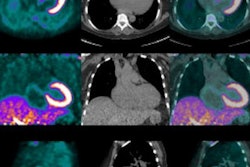"PET/CT imaging has evolved to the extent that it is the best modality for prosthesis imaging," Dr. Sikandar Shaikh, an assistant professor of radiology at the Shadan Institute of Medical Sciences, told AuntMinnie.com. "The reason is CT artifacts and MR compatibility issues. Thus, PET shows the prosthesis involvement by any pathology."
Shaikh and colleagues looked at 37 prosthetic implants in 31 patients suspected of having an infection after artificial hip or knee placement. PET/CT images were acquired 60 to 90 minutes after an intravenous injection of FDG. The images were interpreted as positive for infection if tracer uptake increased at the bone-prosthesis interface with or without CT structural abnormality. A final diagnosis was made by surgical exploration or clinical follow-up at one year.
PET/CT achieved sensitivity of 91%, specificity of 72%, and accuracy of 78% for detecting infection associated with knee prostheses. For infection associated with hip prostheses, sensitivity was 90%, specificity was 89%, and accuracy was 89%. Overall, PET/CT had sensitivity of 90% and specificity of 81% for lower-limb prosthesis infections.
"PET/CT provides the metabolic activity surrounding the prosthesis like inflammatory changes, collection, associated effusions, or soft-tissue components related to infection and tumors," Shaikh said. "At present, this is the best imaging modality for prosthesis imaging."




















